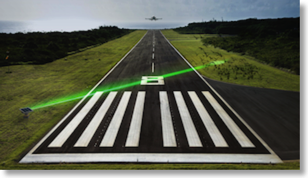Home
A comprehensive resource for safe and responsible laser use
New Zealand: Pilots, legislator want total ban on handheld lasers over 1 mW
The bill would double penalties for violations from the current 3 months imprisonment or $2000 fine, to 6 months or $4000. And it amends the Crimes Act 1961 to make explicit that interference with a transport facility includes using a high-power laser pointer to reduce the ability of aircraft crew to perform their duties.
The High-power Laser Pointer Offences and Penalties Bill was introduced September 6 2018 by Clutha-Southland MP Hamish Walker.
The president of the New Zealand Airline Pilots Association said "We are asking for a prohibition primarily because the risk outweighs markedly, any utility they are having in society. We don't believe they need to be in the country there is plenty of other alternatives as we are calling for a complete prohibition."
In Wellington in August 2018, a $20 million control tower was opened. On its first day of operation, several staffers reported a laser being aimed in their eyes. Some had to lie down after experiencing nausea.
A police database of incidents found 311 reports in 2018 using the keyword "laser."
From the High-power Laser Pointer Offences and Penalties Bill and NewstalkNB.
Germany: Laser/aircraft incidents decline 12.4% compared to last year
This decrease is despite a doubling of incidents at Frankfurt International Airport. In the first half of 2018 there were 22 laser illuminations versus only 11 during the same period in 2017.
Declines were reported at Munich, Hamburg and Stuttgart airports.
A spokesperson for the German pilots' union Vereinigung Cockpit seemed to indicate that increasing prosecutions were a cause of the drop from 2017 to 2018: "A few years ago, the laser attack was a hip prank for some young people. The perpetrators must now be aware that they are consistently prosecuted."
From DW.com reporting on a story from public broadcast service ARD. Thanks to Greg Makhov for bringing this to our attention.
Canada: Restrictions on high-powered handheld lasers in three cities
Persons are banned from possessing such lasers outside of their home, without a legitimate purpose such as work, school, education or astronomy.
Police can question anyone with a laser in one of the prohibited zones if they had a reasonable reason to search them. Examples given included if a member of the public contacted police with a specific description of a person they saw holding a laser, or if police themselves saw the person holding a laser.
Any person with a battery-operated, handheld laser in a prohibited zone 1) outside of a private dwelling and 2) without a legitimate purpose could be fined immediately and “on the spot” up to CDN $5,000. A corporation violating the law would be fined up to CDN $25,000. The fines are in addition to any criminal prosecution; intentionally aiming a laser at an aircraft could result in five years in prison and/or up to CDN $100,000 in fines.
According to Transport Canada, “You don’t need to carry any documentation, but you should be prepared to demonstrate to the officer why you’re in possession of a hand-held laser. Law enforcement will be trained to know when and where people may possess a laser. They will exercise their discretion and judgement when determining whether or not to issue a fine.”
Transport Canada has a webpage with details of the laser prohibitions, a question-and-answer page about the new laser safety measure, and an online forum “Let’s Talk - Lasers” seeking feedback on laser safety issues. The “Let’s Talk - Lasers” consultation closes for comments on August 27 2018.
They also have an online interactive map detailing the prohibited zones. Here are two examples of map output:
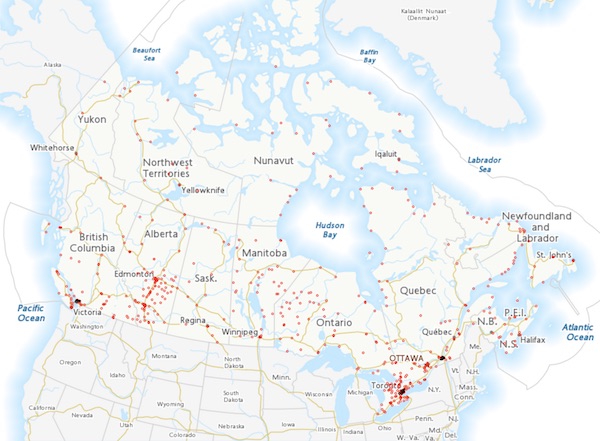
Laser-prohibited zones in the entire country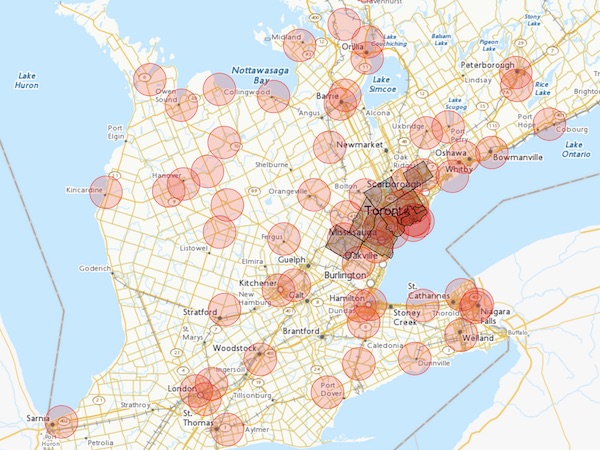
Closeup of laser-prohibited zones in the Toronto area
The three metro areas of Montréal, Toronto and Vancouver were included since, according to Transport Canada, “The majority of reported laser attacks have occurred in these regions. Transport Canada will continue to monitor the number and location of reported incidents and may adjust the included municipalities as warranted.”
The agency discussed how the fines were determined, and how law enforcement will decide on the exact fine amount: “These fines, called administrative monetary penalties, come from the Aeronautics Act and the Canadian Aviation Regulations. Law enforcement uses discretion on how much to fine an individual. The amount may depend on previous infractions and circumstances surrounding this infraction.”
When concluding his announcement, Garneau stated “we have the tools that law enforcement agencies need, including Transport Canada inspectors and police forces, in order to put an end to these careless and reckless actions — actions that could have tragic results.”
From the Canadian Press, the CBC, iPolitics, a video of Marc Garneau’s announcement on GlobalNews.ca, and the Transport Canada informational webpage and Q&A webpage.
For much more information and commentary from LaserPointerSafety.com:
UK: 1,258 laser/aircraft incidents in 2016, a 12.6% drop from 2015
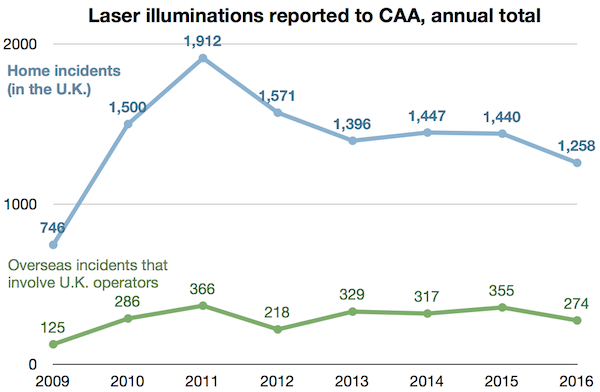
Note: Previous stories and charts elsewhere on LaserPointerSafety.com may have slightly different figures for some years. This is due to CAA updating numbers after a “SDD Coding Backlog”. The numbers above are all as reported in February 2017 by CAA.
The 1,258 home incidents in 2016 represent a 12.6% decrease from the 1,440 home incidents that occurred in 2015.
Similarly, the 274 overseas incidents in 2016 represent a 22.8% decrease from the 355 overseas incidents that occurred in 2015.
Here are the 1,258 home incidents in 2016, month-by-month:
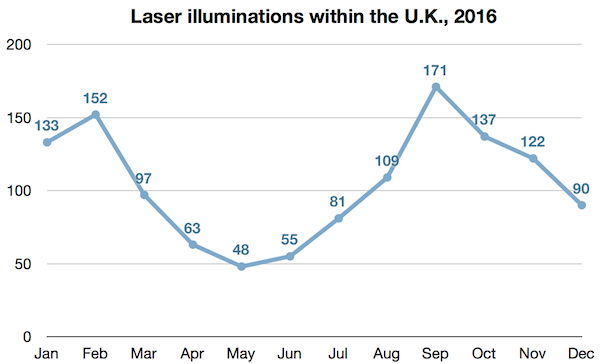
CAA listed the top 10 locations reporting laser incidents for 2016. It is not known whether these incidents all occurred at or near the indicated airports, or whether this also includes incidents (such as helicopter strikes) that occurred elsewhere but which were tallied to the closest airport.
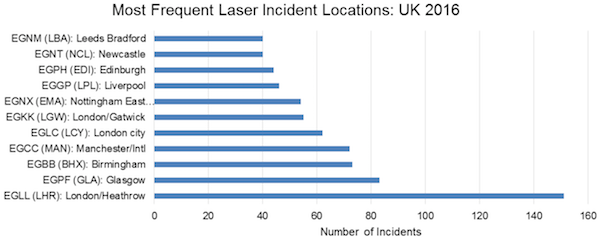
As in the United States, the majority of laser illuminations were reported to be green. The figures below are for U.K. incidents; the color distribution is roughly the same for overseas incidents as well.
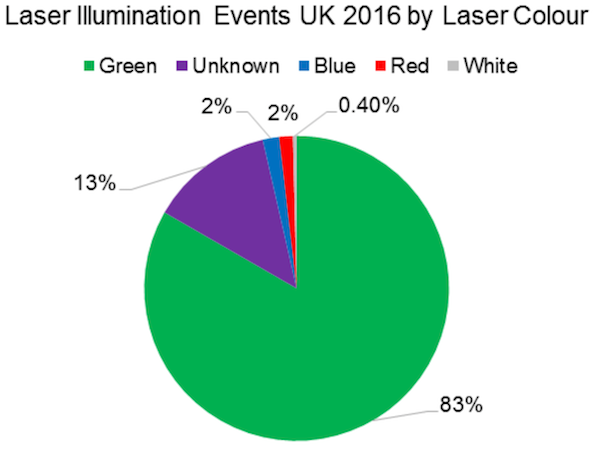
From a February 2017 report by the Civil Aviation Authority. This report contains additional details such as a monthly breakdown for each year 2009-2016, and for each of the top 10 home and overseas locations in 2016.
Portugal: Irish investigators ask Portugal to make aiming lasers at aircraft illegal
This was the sole recommendation resulting from a September 5 2015 incident when the two pilots in a Ryanair flight, on approach to Porto Airport, were illuminated by laser light. The pilot flying was distracted and had to use his hand to shield his eyes. The pilot monitoring had temporary flash blindness lasting a few seconds. This contributed to the aircraft’s approach being “unstable.” The pilots executed a missed approach and did a go-around for a second approach; the plane then landed safely.
Portuguese officials told the Irish investigators that there is no law in Portugal against aiming a laser at an aircraft.
In 2014, there were 294 laser incidents reported in Portugal; in 2015 there were 264 such incidents. In 2014, 107 of the incidents occurred at Porto Airport; in 2015 there were 105 incidents at the airport.
From the Irish Examiner
US: Airport police can go off property to find laser attackers
The measure aims to address people pointing lasers at planes that are taking off or landing and the proliferation of drones near airports. It was signed Tuesday November 22 2016 by Gov. Rick Snyder.
The lasers often are used off airport property but directed at planes while in protected airspace. The beams can fill cockpits with green light and temporarily blind pilots or blur their vision.
From the Detroit Free Press, November 23 2016.
Note from LaserPointerSafety.com: We have been unable to find details about this law. For example, a search of the Michigan Legislature website for bills introduced in 2015-2016 with “laser” as a keyword did not appear to turn up any relevant text. For example, adding “airport” as a search term found no bills at all. A similar search for completed signed bills (“Public Acts”) found a list only with entries prior to August 2016. If anyone has more details about this bill, please contact us.
UK: Police get advice from U.S. FBI on stopping U.K. laser incidents
While both the U.S. and the U.K. have laws with penalties up to five years in jail, in the States jail sentences have been imposed while fines are the norm in Britain. The U.S. also has a centralized national reporting system, which the British officials seek to emulate.
Mark Callaghan, an NPT inspector for Sussex Police, told the Express about a case in April 2014 where a laser beam was aimed at an Airbus A319 from a Travelodge near Gatwick Airport. The pilots reported that “The green laser was extremely aggressive and we suffered three or four two-second attacks directly into the cockpit causing blotchy vision, squinting, broken concentration, sore eyes.” The perpetrators were not caught.
Callaghan noted “We can find out who was in the rooms but we have no power to conduct any searches and even if there were lasers there what evidence is there to say they did it? We would like some preventative legislation. The US have got it nailed on how they deal with this.”
From the Express
Worldwide: Handheld laser being used by airports to disrupt birds
The Aerolaser is made by the Delft, Netherlands company “Bird Control Group”. The handheld device uses a green laser with a range over 2500 meters (1.6 miles). The company claims that birds do not grow used to the laser, and it is safe for the animals. According to an article at the website IHS Airport360, “As a safety feature, the laser is disabled above a certain height - this prevents the beam from being shone directly at aircraft or controllers in the tower.” In addition, the operator can look through a scope so he or she knows where the beam will be directed.
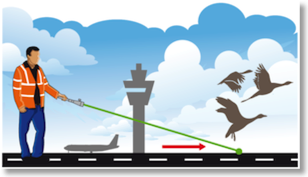
Conceptual diagram of using a handheld laser around airports, from Aerolaser.com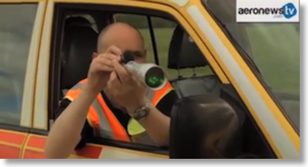
A frame from an Aerolaser video describing use at the Southampton airport.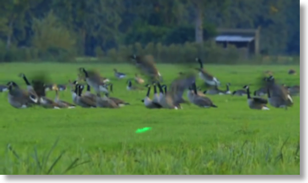
A frame from another Aerolaser video showing laser light scattering birds.
The company also makes an automatic, autonomous system called Aerolaser Groundflex, pictured below from the company’s website:
According to Wikipedia, “bird strikes are a significant threat to flight safety” since 35% of strikes result in damage to the aircraft, costing $400 million per year in the U.S. and up to $1.2 billion per year worldwide.
Bird Control Group also makes the Agrilaser Lite (range of 1000 meters) and the Agrilaser Handheld (range over 2000 meters), intended to keep birds away from fields and crops.
From Aerolaser.com, Agrilaser.com, IHS Airport360, and Wikipedia’s “Bird strike” article
UK: 1300+ laser incidents in 2013
The newspaper also reported that in the 12 months between October 2012 and September 2013, there were 31 reports of aircraft being illuminated as they approached Gatwick Airport, 30 miles south of London.
Laser strikes have also increased on rescue helicopters flying out of Redhill Aerodrome, Surrey, a few miles north of Gatwick. A tactical flight officer was quoted as saying “I've had to break away from a task because of being lasered and it's not because we're trying to catch a bad guy, it's because we're trying to find people potentially in danger.... There are certain elements of society that might be trying to harm us or put us off being in a certain location.”
Police inspector Mark Callaghan told the Mirror that there have been a number of jail terms for perpetrators, but that "Hand-held lasers are easily obtained over the internet or from market stalls and street vendors abroad. The warning labels on these are misleading and they are more powerful than advertised."
From the Surrey Mirror
US: 3,960 laser incidents reported to FAA in 2013
Other news based on the statistics:
- In 2013, there were no incidents documented by FAA as causing eye injuries. Although there were incidents with eye effects such as temporary flashblindness, afterimage, blurry vision, eye irritation and/or headache, no incidents were serious enough to be tabulated as “eye injuries” by the agency. The FAA did say that in 2013, there were 35 incidents where pilots who were lased sought medical attention.
- The closer an aircraft is to the ground, the greater the likelihood of reporting a laser incident. There is a strong peak in the number of incidents at 1000-3000 feet above ground level.
- The color green was reportedly seen in the vast majority (92.8%) of incidents. Blue was a distant second with 2.4% of incidents.
- For states, California had the most incidents (734), followed by Texas (416) and Florida (326).
- For cities and regions, LaserPointerSafety has determined the Los Angeles area, including Van Nuys and Burbank, leads the nation with 147 incidents. Portland Oregon is second with 137 and Houston is third with 124. (Note that LaserPointerSafety.com tabulates regions slightly differently than the FAA or FBI, so these federal agencies may have slightly different numbers or rankings.)
- FAA tabulates each incident according to the closest airport. For 2013, Portland (Oregon) International led this category with 133 incidents. Phoenix Sky Harbor International was second with 111, and Marin International in San Juan, Puerto Rico was third with 107. This does not necessarily mean that incidents occurred at or near these airports -- just that these were the closest airports to the reported incident.
Full details are on the 2013 laser/aircraft incidents page.
Canada: Regina has 12 laser pointer incidents thus far in 2013
This compares with five laser incidents during 2012, and one during 2011.
The officials reminded the public that lasing an aircraft is illegal.
From CTV News and OHS Canada
UK: More than 220 laser attacks in two years in West Midlands, says CAA
This is roughly one-third of the 700 incidents over the same time frame that involved aircraft in or above the West Midlands. (The 480 non-laser incidents included bird strikes, emergency landings, a bomb threat, a dog on the runways and closure of an airfield because of a flying kite.)
On one occasion in July 2011, four different lasers were aimed at a police helicopter in a single incident.
The British Airline Pilots’ Association asked for prison sentences for persons caught aiming at aircraft, as well as regulations over the sale of high-powered lasers.”
According to West Midlands police, laser attacks on their helicopter have fallen in months prior to July 2013.
From the Birmingham Mail. See also a related LaserPointerSafety.com article on BALPA’s laser pointer suggestions.
UK: Pilots want jail for persons aiming laser pens at aircraft
BALPA general secretary Jim McAuslan asked for a government cross-agency summit to address the problem. BALPA requested stronger regulations restricting the sale of high-powered lasers, more prosecutions, and action taken through trading standards.
He said that hotspots include airports at Manchester, Glasgow, Liverpool and Heathrow.
From ITV London and ITV Granada
UK: Leeds Bradford Airport has 3 laser incidents per week
From the Yorkshire Evening Post
UK: 15 laser incidents at East Midlands Airport in 10 months
Police warned of the hazards of endangering pilots and drivers, and noted that a violation could result in being sentenced to prison for life.
From This Is Derbyshire and the Loughborough Echo
South Africa: 181 laser incidents in 2+ years
On March 25 2012, an ATNS statement noted that air traffic control towers have been illuminated by laser light, in addition to airplanes and helicopters. ATNS said there have been at least two arrests, but thus far, no prosecutions.
South African aviation groups are joining together to publicize the hazards and penalties of aiming lasers at aircraft. They are also considering strengthening laws. According to the statement, laser ownership requires a permit, but illegal sales are taking place via imports and black market stores.
From The Star via Independent Online, News 24, and the Daily News. Thanks to Dr. Ian Powell for bringing this to our attention. The ATNS press release is after the link (click “Read More…”).
Click to read more...
US & UK: UPDATED - Laser incident rate in U.K. more than twice the U.S. rate
- U.S. airports had 9,079,000 flights in 2011, with 3,591 laser incidents reported to the Federal Aviation Administration. This is a rate of one U.S. laser incident for every 2,528 flights. Said another way, this is 0.40 incidents per 1,000 flights.
- U.K. airports had 2,152,787 flights in 2011, with 1,909 laser incidents reported to the Civil Aviation Authority. This is a rate of one U.K. laser incident for every 1,128 flights. Said another way, this is 0.89 incidents per 1,000 flights.
The ratio of U.K. to U.S. rates is 2.24, meaning that the U.K. had more than twice the number of laser incidents than the U.S., when adjusted for the number of flights. (Important note: These figures do NOT mean that commercial aircraft are targeted at the rates indicated. Many laser incidents involve police helicopters. The analysis is simply meant to compare the two countries’ rates of laser misuse against aircraft of all types.)
It should also be noted that there could be many underlying factors affecting the precise numbers. For example, it is not known if the U.S. counts laser incidents in the same way as the U.K.
However, the figures do indicate that the U.K. rate of laser incidents appears to be significantly higher -- roughly twice the U.S. rate, based on the number of flights.
From an analysis by LaserPointerSafety.com, March 22 2012.
Updated May 27 2012 to correct a math error and make clear that it is the United Kingdom which has a higher rate of laser incidents (e.g., more incidents per 1000 flights). Our thanks to Brian Turner for pointing out this error.
Methodology: We define a “flight” as a takeoff plus a landing. US flight figures are from the Airline Activity “departures” statistic from the Department of Transportation’s Bureau of Transportation Statistics. It is assumed that each flight which departs also lands, so the data is accurate for “flights” as we have defined it. UK flight figures are from totaling column G, Total ATMs, from “Table 4, 1 Air Transport Movements 2011” found on the CAA UK Airport Statistics 2011 page. A UK “movement” is one takeoff plus one landing, so this is the same as our “flights” definition.
While the flight statistics compare only airline (US) and air transport (UK) flights, and do not include law enforcement flights, we believe this is a valid “apples to apples” comparison of how many more flights take place in the U.S. than in the U.K. A previous LaserPointerSafety.com analysis showed that law enforcement flights are less than 1% of the total flights from U.S. airports. Inclusion of law enforcement flight numbers would not significantly change the ratio of U.S.-to-U.K. flights.
.
US: 2011 total: 3,591 laser/aircraft incidents
Note: The FAA reports the 2011 total as 3,592. This is because the last entry in the FAA’s laser incident spreadsheet is on line 3,592. However, the spreadsheet headings are on line 1, so the actual number of 2011 incidents is 3,591 -- the number we use below.
What is an FAA-reported “laser incident”?: This is defined as an aircraft pilot seeing one or more laser beams during flight. A mid-2011 study by Rockwell Laser Industries of 6,903 incidents reported to the U.S. Federal Aviation Administration found that in 27% of incidents, beams entered the cockpit (passed through the windscreen). For example, in 2011, there were 3,591 incidents of which approximately 970 (27%) involved beams in the cockpit.
PowerPoint version available: A set of slides, presented to the SAE G10 aviation safety committee on Jan. 31, 2012, is available on the Files and Downloads page.
Yearly Comparison
Here are the number of incidents reported to FAA in recent years:- 2011: 3,591 incidents (9.8 per night)
- 2010: 2,836 incidents (7.7 per night)
- 2009: 1,527 incidents (4.2 per night)
- 2008: 949 incidents (2.6 per night)
- 2007: 639 incidents (1.8 per night)
- 2006: 384 incidents (1.1 per night)
- 2005: 283 incidents (0.78 per night)
- 2004: 46 incidents (0.13 per night) involving an unknown number of aircraft Note: FAA mandated that pilots report incidents using Advisory Circular 70-2, beginning January 19 2005. Before this date, pilot reporting was voluntary.
This is a total of approximately 10,201 incidents reported to FAA, from 2004 through the end of 2011.
Adverse Effects
In 55 of the 3,591 laser/aircraft incidents (1.5%), a pilot or aircraft occupant reported a temporary adverse visual effect such as flashblindness, afterimage, blurry vision, eye irritation and/or headache. None of these effects was classified as a recordable injury by FAA medical experts.In these 55 incidents…
- … there were 31 reports of pain or discomfort in the eyes or elsewhere (e.g., headache).
- … there were 31 reports of vision impairment such as afterimages (10) and blurry vision (7).
- … seven persons sought medical treatment after the laser exposure.
- … one person was grounded temporarily.
- … three flights were affected: in two cases, the pilot turned control over to the co-pilot; in one case the pilot felt he had to land immediately.
Rate of increase, by year
While laser incidents continue to increase, during 2011 the rate of increase slowed significantly.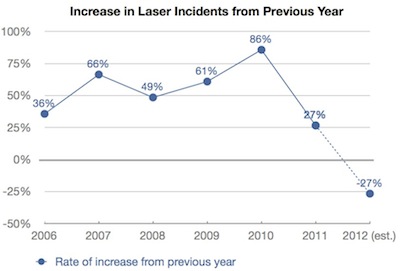
The rate of increase dropped 59% in 2011 (from 86.4% to 27%). If there is another 59% drop in 2012, (dashed line), then there would be a decrease in laser incidents for the first time, from 3,591 incidents in 2011 to 2,836 incidents projected for 2012.
Click to read more...
UK: MP wants action to reduce laser pen attacks at Leeds Bradford Airport
Figures for 2010 showed about 100 laser pen attacks on flights taking off or landing at the Yeadon-based airport. Figures from January 2011 through October 2011 showed 80 such attacks, indicating that the 2011 total would be similar to 2010.
A CAA spokesperson said laser pen misuse in Britain was not letting up in 2011: “The people who are carrying out these attacks are either still ignorant of the dangers high-powered lasers present to the safe operation of an aircraft, or they simply do not care.”
Mulholland said “a blanket ban on laser pointers is not the way forward because of the effect it would have on legitimate users. Something does, however, need to be done to address this serious ongoing issue.”
From the Bradford Telegraph and Argus
New Zealand: Concern over laser incidents
The tower manager, Fred Hanson, was quoted as saying he would like to make lasers illegal because “it just totally changes the light effect in the airplane.” The president of the New Zealand Air Line Pilots’ Association also called for restrictions such as licensing, and having to have a reason for possession: “They do have the potential to wreak a lot of damage.”
A spokeswoman for Air New Zealand said the airline was concerned, and they support prosecution. New Zealand law calls for up to 12 months in prison or a fine of up to $10,000 for interfering with an aircraft. In a current case, two Auckland men are being prosecuted for aiming a laser at a police helicopter.
From the Waikato Times
Note: LaserPointerSafety.com has run two stories to date about New Zealand laser incidents where the penalty was said to be up to 14 years. They can be found here.
Europe: 4,266 laser incidents; harmonized criminal laws sought
In 2008, there were 1,048 European incidents.
A Eurocontrol safety expert said “Preventing and mitigating the current problem requires a harmonized approach throughout Europe. We need the full involvement of regulators, judicial authorities, police, airlines and their associations, air navigation service providers, laser manufacturers who must understand how serious the problem is, as well as research institutes.”
Most European countries do not have specific laws against aiming lasers at aircraft. Eurocontrol stated they should be subject to the same restrictions as firearms, covering the purchase, transportation and use of lasers.
German politician Volker Kauder said that high-powered lasers should be treated as weapons under the Geman Arms Act.
From the Washington Post
US: 2,836 laser events reported in 2010; FAA expresses concern
FAA spokesperson Laura Brown told LaserPointerSafety.com that in roughly 90% of the reports, the cockpit and/or pilot was illuminated by the laser. (In the other 10%, a beam was seen outside the aircraft but light did not enter the cockpit.) As far as injury reports, Brown said that these were “fairly rare”.
The FAA’s press release listed the top 20 affected airports, with Los Angeles International Airport topping the chart with 102 “laser events” in 2010. LaserPointerSafety.com has further analyzed the airport data to show that for these top 20 airports, an event occurred once every 7,000 takeoffs and and landings; the analysis is here.
According to the press release, “[t]he increase in reports is likely due to a number of factors, including the availability of inexpensive laser devices on the Internet; higher power levels that enable lasers to hit aircraft at higher altitudes; increased pilot reporting of laser strikes; and the introduction of green lasers, which are more easily seen than red lasers.”
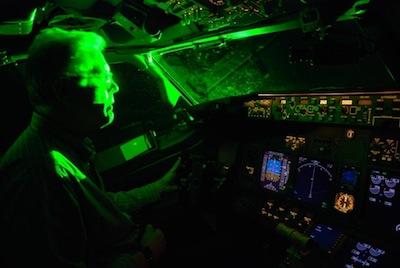
The FAA released the photo above, illustrating what a direct laser illumination of a cockpit can look like.
To read the full FAA press release, and see the list of 20 most affected airports, click the “Read More...” text below. In addition, updated statistics for the current year are here.
